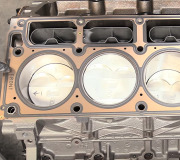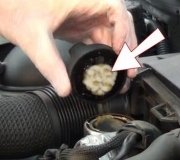Yes you can have a blown head gasket without getting water in the oil or smoke out of the tail pipe. (Though at the beginning of a cold start-up, you should see a small bit of white smoke until the water in the cylinders burns out as steam)
What's happening is exhaust gas is blowing through the blown head gasket and into the cooling system. This puts bubbles into the system that gets trapped inside the heater core (On "reverse-flow" cooling systems like yours, the heater core is the highest point in the system, and the bubbles want to stay in this spot), and doesn't allow the coolant to circulate, thus no heat.
When you rev the motor high (Above 2,000) with the heater on, you should feel some heat. This is because the water pump is spinning fast enough to push the bubbles out of the way. But as more exhaust gas gets into the system, the water pump won't be able to push them anymore. No more heat.
A quick way to verify this is to remove the radiator cap or surge tank cap. Look at the coolant while someone revs your motor up and down to at least 1,500 r.P.M.S. If you see bubbles, then there's your exhaust gas.
Now as for your $1,200 fix, I don't recommend it. The reason is, if your motor has over 100K miles, and got hot enough to blow both head gaskets (rare), what kind of shape do you think the rest of your motor is in? Do you really want to spend $1,200 on a motor that's ready to kick the bucket anyway?
Your money would be better spent on a used motor with half the miles. And it'll come with a 12K-mile/12-month warranty. And the motor and labor will run you about 1,500 total.
Or you could even have your motor rebuilt with a stroker crank (383), rods and pistons for 2,000-2,500.
But whatever you do, don't bother replacing those head gaskets if you aren't going to freshen up the rest of the motor.
Good luck.
SPONSORED LINKS
Monday, February 22nd, 2010 AT 10:00 PM




